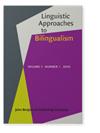Heritage speakers’ processing of the Spanish subjunctive
IF 1.8
2区 文学
0 LANGUAGE & LINGUISTICS
引用次数: 0
Abstract
We investigated linguistic knowledge of subjunctive mood in heritage speakers of Spanish who live in a long-standing English-Spanish bilingual community in Albuquerque, New Mexico. Three experiments examine the constraints on subjunctive selection. Experiment 1 and Experiment 2 employed pupillometry to investigate heritage speakers’ online sensitivity to the presence of the subjunctive with non-variable governors (Lexical conditioning) and with negated governors (Structural conditioning). Experiment 3 employed an elicited production task to examine production of subjunctive in the same contexts. The findings of the heritage group were compared to those of a group of Spanish-dominant Mexican bilinguals. Results showed that in comprehension and production, heritage speakers were as sensitive as the Spanish-dominant bilinguals to the lexical and structural factors that condition mood selection. In comprehension, the two groups experienced an increased pupillary dilation in conditions where the indicative was used but the subjunctive was expected. In addition, high-frequency governors and irregular subordinate verbs boosted participants’ sensitivity to the presence of the subjunctive. In production, there were no significant differences between heritage speakers and Spanish-dominant bilinguals when producing the subjunctive with non-variable and negated governors.传统说话者对西班牙语虚拟语气的处理
我们调查了居住在新墨西哥州阿尔伯克基一个长期的英西双语社区的西班牙语传统使用者对虚拟语气的语言学知识。三个实验考察了虚拟语气选择的制约因素。实验1和实验2采用瞳孔测量法研究了传统说话者对具有非可变调控因子(词汇条件反射)和否定调控因子(结构条件反射)的虚拟语气的在线敏感性。实验3采用一个引出的生产任务来检验在相同语境下虚拟语气的生产。遗产小组的研究结果与以西班牙语为主的墨西哥双语者的研究结果进行了比较。结果表明,在理解和产出方面,传统说话者和西班牙语双语者一样,对制约情绪选择的词汇和结构因素敏感。在理解中,两组在使用指示语但预期使用虚拟语气的情况下瞳孔扩张增加。此外,高频调控词和不规则从属动词提高了参与者对虚拟语气的敏感性。在产生过程中,在使用非可变和否定调控词产生虚拟语气时,母语为传统语的双语者和西班牙语占主导地位的双语者之间没有显著差异。
本文章由计算机程序翻译,如有差异,请以英文原文为准。
求助全文
约1分钟内获得全文
求助全文
来源期刊

Linguistic Approaches To Bilingualism
Social Sciences-Linguistics and Language
CiteScore
3.20
自引率
9.10%
发文量
24
期刊介绍:
LAB provides an outlet for cutting-edge, contemporary studies on bilingualism. LAB assumes a broad definition of bilingualism, including: adult L2 acquisition, simultaneous child bilingualism, child L2 acquisition, adult heritage speaker competence, L1 attrition in L2/Ln environments, and adult L3/Ln acquisition. LAB solicits high quality articles of original research assuming any cognitive science approach to understanding the mental representation of bilingual language competence and performance, including cognitive linguistics, emergentism/connectionism, generative theories, psycholinguistic and processing accounts, and covering typical and atypical populations.
 求助内容:
求助内容: 应助结果提醒方式:
应助结果提醒方式:


